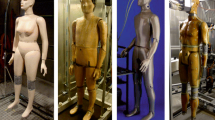Abstract
Thermal manikins have served research and development purposes for more than 60 years. They are widely used for analysing the thermal interface of the human body and its environment. Particular applications are found in the determination of thermal properties of clothing and in the evaluation of the local body-heat fluxes in complex environments such as in a vehicle cabin. Recent developments of sweating manikins as well as breathing manikins allow even more realistic simulations of the human thermal interaction with the environment.
Similar content being viewed by others
References
Anttonen H (1999) Interlaboratory trial of thermal manikin based on thermal insulation of cold protective clothing in accordance with ENV342. Proceedings of the 3rd international meeting on thermal manikin testing, 3IMM, October 1999. National Institute for Working Life, Sweden, pp 8–11
Anttonen H, Holmér I, Meinander H (2003) Subzero project–manikin measurements exact or not? Proceedings of the 2nd European conference on protective clothing and NOKOBETEF 7, May 2003, Montreux, Switzerland
Aubertin G, Cornu J-C (1977) Methode de mesure de l’efficacite de tissus et materiaux composites souples destines a la confection des vetements de protection contre le rayonnement infrarouge. Institut National de Recherche et de Securite, Nancy
Behnke WP, Geshury AJ, Barker RL (1990) “Thermo-man”: Full scale tests of the thermal protective performance of heat resistant fabrics. Proceedings of the 4th international conference on environmental ergonomics, September 1990, Austin, Texas, pp 70–71
Belding HS (1949) Protection against dry cold. In: Newburgh L (ed) Physiology of heat regulation and the science of clothing. Saunders, Philadelphia, pp 351–367
Burke R, McGuffin R (2001) Development of an advanced thermal manikin for vehicle climate evaluation. Proceedings of 4th international meeting on thermal manikins, September 2001, St. Gallen, Switzerland
Burke RA, O’Neill FT, Stricker P (1994) The development of a heat pipe driven manikin with variable flow irrigated skin. Proceedings of the 6th international conference on environmental ergonomics, September 1994, Montebello, Canada, pp 196–197
Buxton A (2001) Recent developments of the virtual manikin. Proceedings of the 4th international meeting on thermal manikins, September 2001, St. Gallen, Switzerland
Dozen Y, Adachi K, Ohthuki S, Aratani Y, Nishizakura K, Saitoh T, Mizutani T, Thuchida K, Kawashima S, Nagai Y, Yamaguchi S, Harada K, Takenishi S (1989) Studies of the heat and moisture transfer through clothing using a sweating thermal manikin. In: Mercer JB (ed) Thermal physiology 1989. Excerpta Medica, Amsterdam, pp 519–524
Dukes-Dobos F, Reischl U (2003) A simple and inexpensive thermomanikin—development of a prototype. Proceedings of the 2nd European conference on protective clothing (ECPC) and NOKOBETEF 7, May 2003, Montreux, Switzerland
Fan J, Chen Y, Zhang W (2001) A perspiring fabric thermal manikin: its development and use. Proceedings of the 4th international meeting on thermal manikins, September 2001, St. Gallen, Switzerland
Hohenstein Institute (2004) Clothing physiology. http://www.hohenstein.org/englisch/abt1.htm. Cited May 2004
Holmér I (2000) Thermal manikins in research and standards. In: Nilsson H, Holmér I (eds) Thermal manikin testing. National Institute for Working Life, Stockholm, pp 4–9
Li Y, Newton E, Luo X, Luo Z (2000) Integrated CAD for functional textiles and apparel. In: Kuklane K, Holmér I (eds) Ergonomics of protective clothing. National Institute for Working Life, Stockholm, pp 8–11
Madsen TL (1989) A new generation of thermal manikins. Thermal Insulation Laboratory, Technical University of Denmark
McCullough E (2001) Interlaboratory study of sweating manikins. Proceedings of the 5th European conference on protective clothing and NOKOBETEF7, May 2003, Montreux, Switzerland
McCullough E (2002) The use of thermal manikins to evaluate clothing and environmental factors. Proceedings of the 10th conference on environmental ergonomics, September 2002, Fukuoka, Japan, pp 427–430
Meinander H (1992) Coppelius—a sweating thermal manikin for the assessment of functional clothing. Proceedings of NOKOBETEF IV: quality and usage of protective clothing, 5–7 February 1992, Kittilä, Finland, pp 157–161
Nielsen PV (2000) The importance of a thermal manikin as source and obstacle in full scale experiments. In: Nilsson H, Holmér I (eds) Thermal manikin testing 3IMM. National Institute for Working Life, Stockholm, pp 92–98
Nilsson HO, Holmér I (2003) Comfort climate evaluation with thermal manikin methods and computer simulation models. Indoor Air 13:28–37
Norén O, Bohm M, Holmér I, Nilsson H, Melikov A, Mayer E, Candas V (1999) Development of standard test methods for evaluation of thermal climate in vehicles. EU Research contract SMT4-CT795-2017, final report
Richards M, Mattle M (2001) Development of a sweating agile thermal manikin—SAM. Proceedings of the 4th international meeting on thermal manikins, September 2001, St. Gallen, Switzerland
Tanabe S, Ozeki Y (2002) Numerical comfort simulator for evaluating thermal environment. Proceedings of the 10th international conference on environmental ergonomics, September 2002, Fukuoka, Japan, pp 435–438
Tanabe S, Zhang H, Arens EA, Madsen TL, Bauman FS (1994) Evaluating thermal environments by using a thermal manikin with controlled skin surface temperature. Hum Env Engin 3739–3748
US Army Research Institute of Environmental Medicine (2001) The Biophysics and Biomedical Modeling Division. http://www.usariem.army.mil/bphysics/metallic_models.html. Cited February 2001
Wyon D (1989) Use of thermal manikins in environmental ergonomics. Scand J Work Environ Health, 15[Suppl 1]:84–94
Wyon D, Larsson S, Forsgren B, Lundgren I (1989) Standard procedures for assessing vehicle climate with a thermal manikin. Technical paper series, no. 890049. Society of Automotive Engineers, Detroit
Author information
Authors and Affiliations
Corresponding author
Rights and permissions
About this article
Cite this article
Holmér, I. Thermal manikin history and applications. Eur J Appl Physiol 92, 614–618 (2004). https://doi.org/10.1007/s00421-004-1135-0
Accepted:
Published:
Issue Date:
DOI: https://doi.org/10.1007/s00421-004-1135-0




